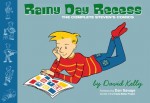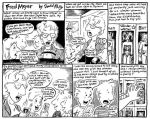After Teleny and Glamazonia, Northwest Press continues to impress me with their publishing choices, as they now offer a complete collection of David Kelly’s Steven Comics, under the title Rainy Day Recess. I’d written a review of the original mini-comics from the mid 90s, themselves collecting strips from independent weeklies, at the beginning of this website, but reading the new 120-page collection1 makes for an even stronger reading experience, so I’m going to try and expand upon my original review.
Steven is a 9 or 10-year-old boy from a divorced family growing up in the late 70s, early 80s, who tells stories from his own life, the life of a boy who’s often teased (we’d say “bullied” nowadays) for not being boyish enough: he loves Barbie dolls, is more interested in nail polish than sports, and has a crush on another boy. Stories about gay boys (as opposed to stories about gay teens or men) weren’t numerous when Kelly launched his strips and in fact still aren’t, but the years since have seen some changes, especially in the public perception of the subject. The fact that Dan Savage has written an introduction for Rainy Day Recess is of course very significant: I’ve found his It Gets Better campaign toward gay youth very interesting, especially since I can’t see something like that happening in my own country. Anyway, that’s not the point. The point is that American culture seems to be at a tipping point, where queer people are being mainstreamed and homophobes are finally being shown by the general culture as the danger they really are, the same way antisemitism and not Jewish people are the problem. That sounds so obvious, but the way that it is now seeping through popular culture makes me a bit more optimistic. In that regard, David Kelly’s strips are even more relevant than they were a decade and a half ago.
The first series of strips shows Steven on a serious quest: he’s discovered the existence of super-heroes “action figures”, which include Wonder Woman. How could he resist her? But there’s the fear of being called a sissy… Steven’s inner struggle is portrayed in a matter-of-fact way, carried by the voice of the boy himself, as are all the other strips. The first-person narrative is a choice that could be restricting, especially with a preteen protagonist, but combined with the nuanced naiveté that characterizes Steven, it brings a freshness that elevates those strips above the “Look how cute he is!” factor.
Over the course of these first strips, we also meet Steven’s family: his single mother, his sister Kim, and his younger brother Tim. We’ll later learn about his two older brothers, who are in their mid/late teens and are not often home. Kelly avoids the obvious pitfall of giving his character a screwed-up family, but doesn’t shy away from portraying people who are definitely not well-off.
The second series of strips introduces a very important character: Christopher is a new boy in Steven’s class, and the subject of Steven’s first real crush. The strips with Christopher are the most tender of the book, with Steven and Christopher’s friendship slowly becoming something more. And contrary to a lot of stories where a gay teen gets a crush on a straight boy, here we have another boy who responds to Steven’s feelings, for example in a very cute strip around Valentine’s Day. Christopher is shown as another gay guy in the making, in a more assured way than Steven.
Kelly also introduces Starwoman, a super-heroine created by Steven, something of a mash-up between Wonder Woman and Supergirl. Steven dreams himself as her costume designer, best friend and sidekick all rolled into one, and her stories add a whimsical aspect that perfectly complements the down-to-earth daily life of Steven’s family, which is also developed here and in the following strips.
A year or so of strips makes a lot of difference in Kelly’s art: the first stories are drawn in a style that’s not too assured, with characters sometimes having trouble keeping to model, and some cluttered panels. But by the end of this series, Kelly’s line has become far more assured and is on the path toward his current style: a very clean line art with a simple and effective composition.
Growing up gay is not the only theme of these strips. Family is also one, and the following sequence, entitled “We are Family”, juxtaposes the history of Steven’s family life, his discovery of Christopher’s family, and the hard life of one of Steven and Christopher’s classmates whose mother dies and whose father is abusive. From his parents shouting at each other before their divorce to his problems with his mother’s new boyfriend, Steven’s years are not filled with stability. And the decision of his mother to send him and his younger brother to live with their grandmother doesn’t make it any easier. I really liked the way David Kelly manages to show how resilient kids can be, by cutting Steven off from the few people who are essential to him (his mother and Christopher, more or less) and transplanting him in new surroundings. The ambiance of those strips is bitter-sweet, and Steven is shown missing his mother, but he also begins to meet new people and find kindred souls in unexpected situations. And his new crush is Troy, a teenager who teach kids how to swim, a young man who’s nice to the younger kids. In fact, the balance between situations which tend to tug at the heartstrings and kind people who somehow make up for those situations is one of the heartwarming features of Kelly’s strips.
The series of strips ends on a hopeful note for Steven, in the form of a letter from his mother (whose contents I won’t reveal, it would be a pity). The rest of the book is filled to the brim with illustrations, by David Kelly and friends, with short stories published here and there, and with some all-new strips, set during the early ones or after the last ones.
Rainy Day Recess is a collection that will reward multiple readings, for its author’s attention to details, both in his characters and in their surroundings. It is as engaging as it is heartfelt, but more than that, it stands as a realistic but ultimately optimistic portrait of a gay kid. We can only believe that Steven grew up to be a good guy who made another man, or maybe other men, feel happy and loved.
Notes:
- You can buy this book your local comics shop, who should have it as I write this, from the publisher or from Amazon
. ↩




 Bluesky feed
Bluesky feed